Cloud Computing architecture
Cloud Computing architecture comprises of many cloud components, which are loosely coupled. We can broadly divide the cloud architecture into two parts:
- Front End
- Back End
Each of the ends is connected through a network, usually Internet. The following diagram shows the graphical view of cloud computing architecture:
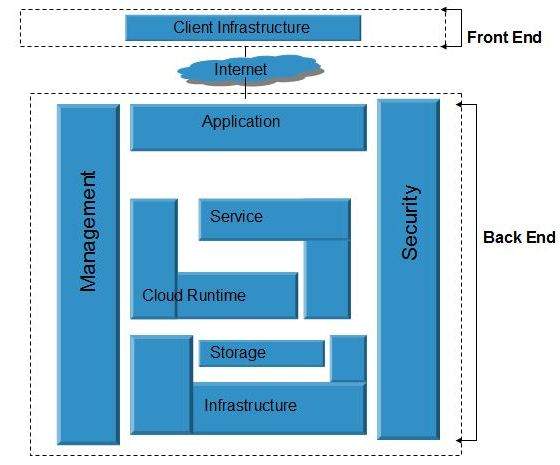
Front End
The front end refers to the client part of cloud computing system. It consists of interfaces and applications that are required to access the cloud computing platforms, Example – Web Browser.
Back End
The back End refers to the cloud itself. It consists of all the resources required to provide cloud computing services. It comprises of huge data storage, virtual machines, security mechanism, services, deployment models, servers, etc.
Note
- It is the responsibility of the back end to provide built-in security mechanism, traffic control and protocols.
- The server employs certain protocols known as middleware, which help the connected devices to communicate with each other.
Cloud infrastructure consists of servers, storage devices, network, cloud management software, deployment software, and platform virtualization.

Hypervisor
Hypervisor is a firmware or low-level program that acts as a Virtual Machine Manager. It allows to share the single physical instance of cloud resources between several tenants.
Management Software: It helps to maintain and configure the infrastructure.
Deployment Software: It helps to deploy and integrate the application on the cloud.
Network:
It is the key component of cloud infrastructure. It allows to connect cloud services over the Internet. It is also possible to deliver network as a utility over the Internet, which means, the customer can customize the network route and protocol.
Server
The server helps to compute the resource sharing and offers other services such as resource allocation and de-allocation, monitoring the resources, providing security etc.
Storage
Cloud keeps multiple replicas of storage. If one of the storage resources fails, then it can be extracted from another one, which makes cloud computing more reliable.
Infrastructural Constraints
Fundamental constraints that cloud infrastructure should implement are shown in the following diagram:
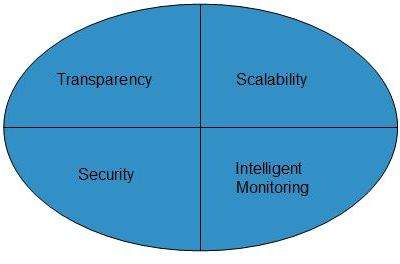
Transparency
Virtualization is the key to share resources in cloud environment. But it is not possible to satisfy the demand with single resource or server. Therefore, there must be transparency in resources, load balancing and application, so that we can scale them on demand.
Scalability
Scaling up an application delivery solution is not that easy as scaling up an application because it involves configuration overhead or even re-architecting the network. So, application delivery solution is need to be scalable which will require the virtual infrastructure such that resource can be provisioned and de-provisioned easily.
Intelligent Monitoring
To achieve transparency and scalability, application solution delivery will need to be capable of intelligent monitoring.
Security
The mega data center in the cloud should be securely architected. Also the control node, an entry point in mega data center, also needs to be secure.
Public Cloud allows systems and services to be easily accessible to general public. The IT giants such as Google, Amazon and Microsoft offer cloud services via Internet. The Public Cloud Model is shown in the diagram below.
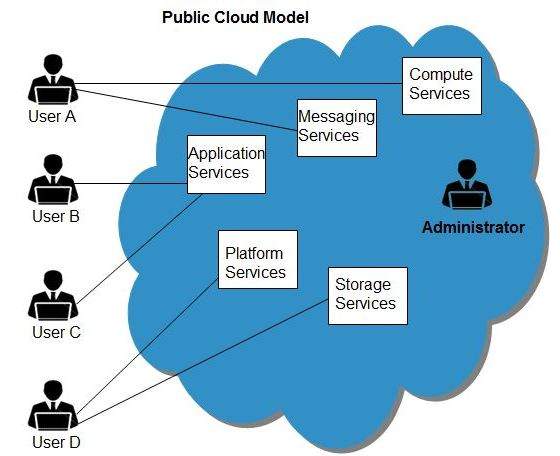
Benefits
There are many benefits of deploying cloud as public cloud model. The following shows some of those benefits:
Cost Effective
Since public cloud shares same resources with large number of customers it turns out inexpensive.
Reliability
The public cloud employs large number of resources from different locations. If any of the resources fails, public cloud can employ another one.
Flexibility
The public cloud can smoothly integrate with private cloud, which gives customers a flexible approach.
Location Independence
Public cloud services are delivered through Internet, ensuring location independence.
Utility Style Costing
Public cloud is also based on pay-per-use model and resources are accessible whenever customer needs them.
High Scalability
Cloud resources are made available on demand from a pool of resources, i.e., they can be scaled up or down according the requirement.
Disadvantages
Here are some disadvantages of public cloud model:
Low Security
In public cloud model, data is hosted off-site and resources are shared publicly, therefore does not ensure higher level of security.
Less Customizable
It is comparatively less customizable than private cloud.
Private Cloud
Private Cloud allows systems and services to be accessible within an organization. It is operated only within a single organization. However, it may be managed internally by the organization itself or by third-party. The private cloud model is shown in the diagram below.
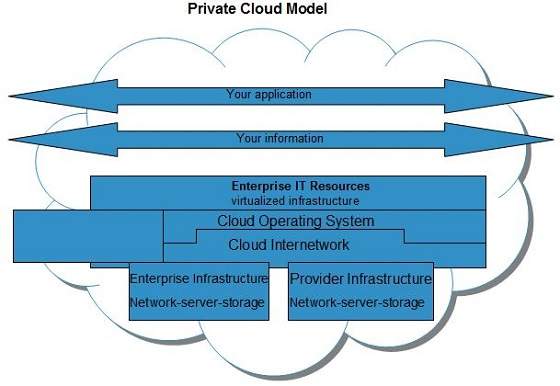
Benefits
There are many benefits of deploying cloud as private cloud model. The following diagram shows some of those benefits:
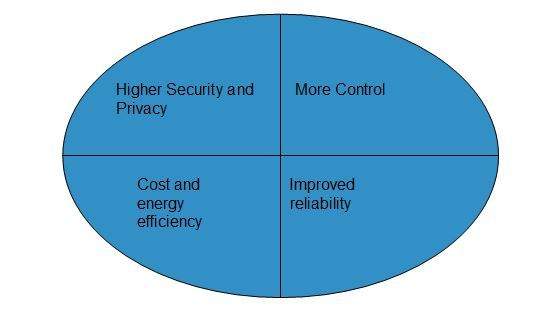
High Security and Privacy
Private cloud operations are not available to general public and resources are shared from distinct pool of resources. Therefore, it ensures high security and privacy.
More Control
The private cloud has more control on its resources and hardware than public cloud because it is accessed only within an organization.
Cost and Energy Efficiency
The private cloud resources are not as cost effective as resources in public clouds but they offer more efficiency than public cloud resources.
Disadvantages
Here are the disadvantages of using private cloud model:
Restricted Area of Operation
The private cloud is only accessible locally and is very difficult to deploy globally.
High Priced
Purchasing new hardware in order to fulfill the demand is a costly transaction.
Limited Scalability
The private cloud can be scaled only within capacity of internal hosted resources.
Additional Skills
In order to maintain cloud deployment, organization requires skilled expertise.
Hybrid Cloud
Hybrid Cloud is a mixture of public and private cloud. Non-critical activities are performed using public cloud while the critical activities are performed using private cloud. The Hybrid Cloud Model is shown in the diagram below.
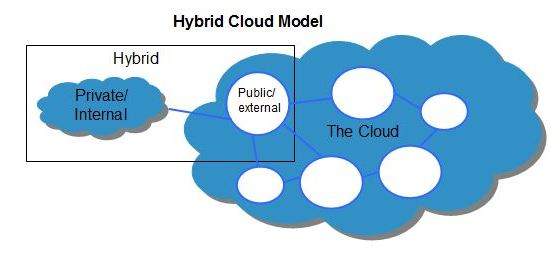
Benefits
There are many benefits of deploying cloud as hybrid cloud model. The following shows some of those benefits:
Scalability
It offers features of both, the public cloud scalability and the private cloud scalability.
Flexibility
It offers secure resources and scalable public resources.
Cost Efficiency
Public clouds are more cost effective than private ones. Therefore, hybrid clouds can be cost saving.
Security
The private cloud in hybrid cloud ensures higher degree of security.
Disadvantages
Networking Issues
Networking becomes complex due to presence of private and public cloud.
Security Compliance
It is necessary to ensure that cloud services are compliant with security policies of the organization.
Infrastructure Dependency
The hybrid cloud model is dependent on internal IT infrastructure, therefore it is necessary to ensure redundancy across data centers.
Community Cloud
Community Cloud is allows system and services to be accessible by group of organizations. It shares the infrastructure between several organizations from a specific community. It may be managed internally by organizations or by the third-party. The Community Cloud Model is shown in the diagram below.
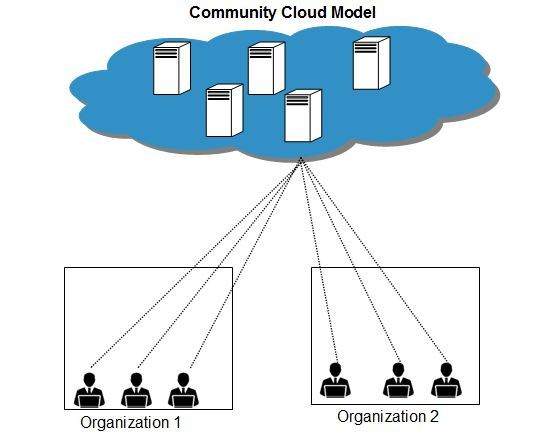
Benefits
There are many benefits of deploying cloud as community cloud model.
Cost Effective
Community cloud offers same advantages as that of private cloud at low cost.
Sharing Among Organizations
Community cloud provides an infrastructure to share cloud resources and capabilities among several organizations.
Security
The community cloud is comparatively more secure than the public cloud but less secured than the private cloud.
Issues
- Since all data is located at one place, one must be careful in storing data in community cloud because it might be accessible to others.
- It is also challenging to allocate responsibilities of governance, security and cost among organizations.

0 Comments